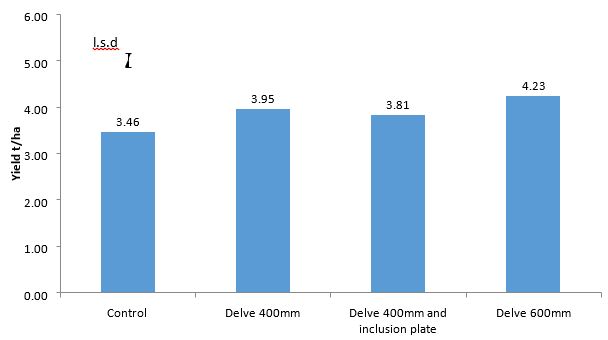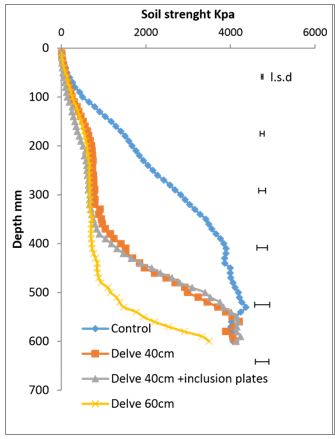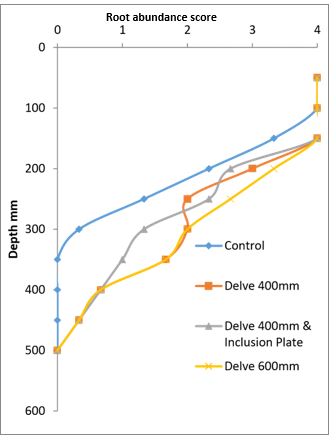Ripping and clay delving responses on shallow clay duplex soil: First year results from a site at Grass Patch WA
Author: Tom Edwards, Giacomo Betti, David Hall, Stephen Davies, Aidan Sinnot, Department of Primary Industries and Regional Development SEPWA | Date: 26 Feb 2018
Key Messages
- All clay delving treatments significantly improved crop yield up to 770kg/ha in the first year of the trial.
- Though delving treatments did not significantly improve crop emergence, soil strength was reduced and root abundance was increased at depth in the clay-rich B horizon.
- Evaluating the physical changes of the soil through delving is important if we hope to understand how to optimise delving methods for each situation.
Aims
Shallow sodic duplex soils (Sodosols) are commonly encountered in the transitional Mallee region of southern Western Australia (Moore 2001).These soils have physical properties that can restrict productivity of crops through both a non-wetting sand layer on top of a compacted clay layer that restricts root growth (Hall et al. 2009). Trials and grower experience have demonstrated that delving can be an effective soil renovation method for these shallow duplex soils and can be much more cost efficient than clay spreading (Davenport et al. 2011).
Delving involves running modified ripping tines through a clay rich B horizon at an angle that will peel the clay back and ride up the tines to be deposited on the surface (Bailey and Hughes 2012).This clay incorporated through the topsoil can reduce the expression of non-wetting and the ripping-like effect of the delver allows the roots to penetrate deeper by reducing the soil strength and improving the porosity of the clay layer (Davenport et al. 2011). The clay layer can be an excellent resource of stored nutrients and water if crop roots can penetrate it (Betti 2015). However, delving is still an expensive exercise and reliable yield improvements are required to justify the investment cost (Betti et al. 2017).
Identifying the right situation and soil type is crucial to obtaining the best results with delving. First, the grower must be confident that the clay does not contain any hostile elements that will be detrimental if brought to the surface. Subsequently the depth to clay is the most crucial consideration. For the Mallee duplex soils where the clay layer is relatively shallow (≈300mm) there is a risk that too much clay will be brought up, creating an uneven and challenging bed to seed into.
This trial examines a hybrid ripper delving machine which has more tines with narrower faces compared to a typical clay delver. This design will excavate less clay but create more pathways where the subsoil has been penetrated and loosened (Davenport et al. 2011). However the depth of the clay layer is highly variable across most paddocks and where it is too deep it is likely that very little clay will be brought to the surface. Therefore, topsoil constraints are unlikely to be overcome although there may be a ripping benefit (Davenport et al. 2011).
By evaluating the changes in the physical properties as a result of delving we can compare the contribution of both the ripping and clay excavation effect on crop production (Betti et al. 2017). This trial aims to also compare how effectively these constraints are overcome across a large spatial area with variable depths to clay. We believe this will allow us to provide better guidelines around when, where and how to delve to deliver consistently better yields on shallow duplex soils.
Method
The trial was established at Grass Patch on a grey shallow sandy duplex. Three replicates of soil samples were taken for each of the twelve plots to a depth of 500mm and sent for lab analysis (Table 1) prior to any soil renovation. A molarity of ethanol test (King 1981) was undertaken for the top 100mm to determine the degree of potential nonwetting both before and after the treatments.
In April 2017 four treatments were imposed: a control where no soil renovation was undertaken, delving to 400mm only, delving to 400mm with inclusion plates and delving to 600mm. Each treatment was replicated three times in randomised block design. The Gessner® ripper-delver had parabolic shaped tines 320mm wide, 500mm apart.
Following the soil renovation the trial was sown in mid-April to La Trobe Barley at 70kg/ha. The crop was assessed for crop emergence, vigour with NDVI and peak biomass during the growing season.
Soil strength was evaluated in August using a Rimik® CP40-II penetrometer to record cone index values at 20mm intervals to a depth of 600mm. Five replicates were taken for each plot each with three insertions. Four soil pits were excavated at the end of July, one for each treatment in the third block. Root abundance and depth was then assessed on the face of each pit as detailed in (McDonald et al. 1998). The whole plots (12m x 122m) were harvested in the same direction using a 12m front and weighed with a harvest weight trailer.
Table 1 Soil physical and chemical properties at the Grass Patch site in April 2017 prior to any soil renovation
Depth | pH | Colwell | Organic | EC | Boron | eCEC | Exc | MED | MED |
|---|---|---|---|---|---|---|---|---|---|
0-100 | 5.41 | 26.00 | 0.55 | 0.056 | 0.35 | 1.56 | 8.65 | 3.2 | 1.9 |
100-200 | 5.56 | 22.22 | 0.30 | 0.057 | 0.29 | 1.02 | 15.19 | ||
200-300 | 6.24 | 26.13 | 0.15 | 0.069 | 0.45 | 1.10 | 23.68 | ||
300-400 | 6.62 | 85.50 | 0.12 | 0.091 | 1.75 | 2.98 | 30.66 | ||
400-500 | 6.94 | 153.22 | 0.11 | 0.123 | 4.61 | 5.91 | 29.88 |
Results
Delving to a depth of 600mm delivered a 770kg/ha yield benefit and all soil renovation treatments significantly increased yields in the first year (Figure 1). Non-wetting (MED test) of the control was not significantly decreased by any of the treatments nor was crop emergence changed. After 18 weeks of growth all soil renovation treatments recorded a statistically significant increase (at P=0.05) in the number of tillers/m2. For all treatments, the increase in biomass was statistically significant and a 1.5t/ha increase was observed for the delved to 600mm treatment (Table 2). No difference was observed for any treatments in the plant tissue nutrition at the 18 weeks period (Data not shown).
Figure 1: Yield (t/ha) of La Trobe Barley at the Grass Patch trial 2017 (LSD P=0.05=0.15t/ha).
Compared to the control, soil strength (Figure 2) was significantly reduced by all treatments at 200mm, 300mm and 400mm depth increments. Additionally the soil strength was also significantly reduced by the 600mm delve treatment to a depth of 500mm. Soil strength of the control is above the level considered restrictive to root growth (2500kPa) 280mm into the profile. Delve to 400mm +/- inclusion plates does not reach 2500kPa until 470mm into the profile and delve to 600mm not until 570mm deep.
Table 2: Recorded plant measurements for 2017 growing season within the Grass Patch trial.
Treatment | MED June | Plant emergence | Tiller/m2 | Biomass (t/ha) |
|---|---|---|---|---|
Control | 1.9 | 77 | 717 | 4.0 |
Delve 400mm | 2.0 | 76 | 844* | 5.4* |
Delve 400mm and inclusion plate | 1.9 | 72 | 822* | 5.4* |
Delve 600mm | 1.9 | 93 | 861* | 5.5* |
LSD (0.05) | 0.3 | 18 | 64 | 0.7 |
Numbers followed by * were significantly (P<0.05) different to the Control.
All treatments recorded similar root score values until the 300mm depth increment (Figure 3). No root growth was observed for the control below 300mm conversely all delving treatments continued to record root numbers, albeit reducing, to a depth of 500mm into the soil profile.
Figure 2: Cone penetrometer readings for the trial at Grass Patch 2017. Measurements taken every 20mm of depth to 600mm. least significant difference at a 5% level displayed for 100mm increments.
Figure 3: Root abundance scored 1–4 according to the method described in Land and Soil Classification (McDonald et al. 1998). Ratings were given for each 50mm x 100mm grid down to a depth of 500mm.
Conclusion
Significant yield gains were observed for all of the soil renovation treatments in the first year after intervention. This supports the findings of Betti et al (2017) that delving can significantly increase the productivity of shallow duplex soils.
The majority of this benefit seems attributable to an increased in root abundance at depth, due to a decrease in subsoil strength after clay delving. Betti (2015) concluded that greater root density at depth translates to better access to the clay rich subsoil and the higher nutrient and water holding capacity it possesses. Therefore, modifying the soil profile through delving provides more benefit than just overcoming soil water repellence (Bailey and Hughes 2012).
Despite the yield increase there is no evidence that the delving process mitigated soil water repellence in this trial. Emergence was consistent and adequate across all of the treatments suggesting that non-wetting was not a constraining factor in this season. However the results show that this site can be characterised as severely nonwetting and is therefore likely to be an issue in other years.
Typically, masking the expression of non-wetting requires the organic topsoil to have over 5% in clay content (Davenport et al. 2011). Potentially, the delving operation did not bring enough clay to the surface to achieve this threshold. This may be attributable to the insufficient width of the tines. Usually, delving tines are 100-175mm wide (Davenport et al. 2011), equivalent to approximately three times the width of the tines used in this trial. Additionally, the subsoil moisture conditions while clay delving may not have been ideal for soil flow. Considerable summer rainfall saturated the clay sub layers, which cause the clay to become quite plastic and prone to smear as opposed to fracturing and breakout (Spoor 2006).
Though this trial highlights the great potential of clay delving to increase crop production for these soils, sufficient amounts of clay are required to be brought to the surface to get the full benefit of delving for the long term (Davenport et al.). Conversely as the response to soil loosening was so significant, potentially ripping may provide a more cost effective approach in this scenario. Therefore it is important to continue this research for several years to allow us to further evaluate how the changes to the soil parameters endure to better answer this question. Additionally, further work is required to evaluate the potential use of precision agriculture technologies to accurately determine the depth to clay over large areas so that suitable amounts of clay can be brought to the surface consistently on a meaningful scale.
References
Bailey, G, Hughes, B (2012) 'An observational study of clay delving and its impact on the A2 horizon in sand over clay soils, Proceedings of the 5th joint Australia and New Zealand soil science conference. Australian Society of Soil Science Inc, Hobart.'
Betti, G (2015) Effect of clay delving on water and carbon storage: a case study in the South East of South Australia.
Betti, G, Hall, D, Edwards, T, Davies, S (2017) 'Clay delving for the amelioration of water repellent soils: first year results from a site near Esperance, Grains research updates WA.' Burswood WA.
Davenport, D, Hughes, B, Davies, S, Hall, D (2011) Spread, delve, spade, invert: a best practice guide to the addition of clay to sandy soils. Rural Solution SA, Agricultural Bureau of South Australia, Caring for our Country,
Grains Research Development Corporation. Grains Research and Development Corporation (GRDC), No. 9781921779275.(GRDC: Kingston, ACT)
Hall, D, Lemon, J, Oliver, Y, Gazey, C, Davies, S, Russell, C, Whitham, N (2009) 'Managing South Coast Sandplain Soils to Yield Potential.' (Department of Agriculture and Food, Western Australia: South Perth)
King, P (1981) Comparison of methods for measuring severity of water repellence of sandy soils and assessment of some factors that affect its measurement. Soil Research 19, 275-285.
McDonald, RC, Isbell, R, Speight, JG, Walker, J, Hopkins, M (1998) 'Australian soil and land survey: field handbook.' (CSIRO publishing: Clayton, Victoria)
Moore, GA (2001) 'Soilguide (Soil guide): A handbook for understanding and managing agricultural soils.' (Department of Agriculture and Food, WA: Perth Western Australia)
Spoor, G (2006) Alleviation of soil compaction: requirements, equipment and techniques. Soil Use and Management 22, 113-122.
Acknowledgments
We would like to acknowledge the Curnow family for hosting the trial and their help.
This research is funded by GRDC and DPIRD through DAW00244 soil water repellence project which is one of the GRDC Soil Constraints West group of projects.
GRDC Project Number: DAW00244
Peer Reviewed By: Chris Gazey
GRDC Project Code: DAW00244,
Was this page helpful?
YOUR FEEDBACK



